Navigation
Install the app
How to install the app on iOS
Follow along with the video below to see how to install our site as a web app on your home screen.

Note: this_feature_currently_requires_accessing_site_using_safari
More options
You are using an out of date browser. It may not display this or other websites correctly.
You should upgrade or use an alternative browser.
You should upgrade or use an alternative browser.
seating depth
- Thread starter jdl420
- Start date
rick smith
Handloader
- Apr 6, 2005
- 1,249
- 0
I use 0.005" for adjustments.Rick.
Richracer1
Handloader
- May 12, 2005
- 2,145
- 146
rick smith":2i1rm805 said:I use 0.005" for adjustments.Rick.
+1 on .005
DrMike
Ballistician
- Nov 8, 2006
- 38,108
- 8,112
For precision, 0.005 will get you where you want to go.
Most of the time you will find a node of close to 10 thousands variance where a certain bullet load combo will shoot best. To find that node I use the 5 thousands between loads seating depth also.
I might add that I have found that in many of my rifles they like Nosler ballistic tips and Accubonds 10 thousands off the lands most of time.
I might add that I have found that in many of my rifles they like Nosler ballistic tips and Accubonds 10 thousands off the lands most of time.
roysclockgun
Handloader
- Dec 17, 2005
- 736
- 2
Because I have adhered to the belief that closer to the lands will be better, I begin by finding at what length the bullet will touch the lands, by coating the bullet with fiber tipped pen ink and loading the cartridge in the chamber. Once the "touching length" is assertained, I reduce OAL by two or three thousandth inch, until no more marks made by the lands can be detected on the inked bullet, under strong light. At that point, I back off .005 inch and load five cartrides at that length. Then load another five at .005 inch less, and so on. I will be able to find which OAL works best in that rifle, with that bullet and that load. Of course, with magazine rifles one is limited to the length of the magazine, unless one is willing to load single rounds.
The ink will wipe off and regardless, cannot hurt the bore anyway.
Maybe not the best method, but it has worked for me.
Steven
The ink will wipe off and regardless, cannot hurt the bore anyway.
Maybe not the best method, but it has worked for me.
Steven
sithlord6512
Beginner
- Nov 24, 2008
- 107
- 0
For the recommendation of .005" changes in seating depth, is that for the whole range of possible seating depths
e.g., .030"-.100"= 14 different seating depths = 42 rounds of 3-shot groups.
or is that for fine tuning once you have isolated a general range of good seating depths
e.g., .030", 0.60", .090", .120" 3-rnd test groups, Best group at .090",
Then
.080", .085", .095", .100" = 27 rounds in total
e.g., .030"-.100"= 14 different seating depths = 42 rounds of 3-shot groups.
or is that for fine tuning once you have isolated a general range of good seating depths
e.g., .030", 0.60", .090", .120" 3-rnd test groups, Best group at .090",
Then
.080", .085", .095", .100" = 27 rounds in total
RiverRider
Handloader
- Dec 9, 2008
- 1,478
- 153
I use .005" increments and decrements also. Someone once remarked to me that a great place to start is one tenth of a caliber off the lands, and this has worked well for me. It seems to be within .010" of the optimum depth most of the time.
Sometimes I can get nowhere near the lands, and when that happens I'll resort to a Stoney Point (now Hornady) comparator. I'll just start with a recommened OAL and vary the depth, plus and minus, by my favored .005" intervals.
Sometimes I can get nowhere near the lands, and when that happens I'll resort to a Stoney Point (now Hornady) comparator. I'll just start with a recommened OAL and vary the depth, plus and minus, by my favored .005" intervals.
- Thread starter
- #9
RiverRider
Handloader
- Dec 9, 2008
- 1,478
- 153
Well jdl, yes---but you might want to try a few increments in the other direction also. My .222 likes them seated .015" from the lands, and my .223 likes .020" from the lands. Since we're only talking four different depths less that a tenth of a caliber for .22 centerfires, I did try .005," .010," .015," and .020" with both as well as .025" and .030." Truth is though, I never got out to .050" and I really don't KNOW that it wouldn't work even better than what I have chosen to do. I figure that getting sub half-inch groups with sporter weight rifles consistently is good enough.
I have pretty much gone to a modified "Berger" method. It works well with a VLD bullet design.. Once I find my optimum velocity/safe psi zone I take that load and seat at 0.00, 0.020, 0.040, & 0.060 off lands. From there, I take the better grouping & then I start tweaking by 0.005 increments.
Rod
Rod
- Nov 4, 2004
- 26,751
- 12,742
I also go 0.005" increments.
JD338
JD338
RiverRider
Handloader
- Dec 9, 2008
- 1,478
- 153
nodak7mm":ih5vimog said:I have pretty much gone to a modified "Berger" method. It works well with a VLD bullet design.. Once I find my optimum velocity/safe psi zone I take that load and seat at 0.00, 0.020, 0.040, & 0.060 off lands. From there, I take the better grouping & then I start tweaking by 0.005 increments.
Rod
I think I'll give that a try.
Antelope_Sniper
Handloader
- Jan 25, 2008
- 2,618
- 0
Another for .005.
Here is an interesting article. They mention some starting depth for different manufactures. This might save you a few rounds.
http://www.mamut.net/MarkBrooks/newsdet32.htm
George
http://www.mamut.net/MarkBrooks/newsdet32.htm
George
sithlord6512":2n5g6rs3 said:For the recommendation of .005" changes in seating depth, is that for the whole range of possible seating depths
e.g., .030"-.100"= 14 different seating depths = 42 rounds of 3-shot groups.
or is that for fine tuning once you have isolated a general range of good seating depths
e.g., .030", 0.60", .090", .120" 3-rnd test groups, Best group at .090",
Then
.080", .085", .095", .100" = 27 rounds in total
x2
Most of the time it is extremely difficult to seat your bullets with less than .005" variance and IME you will not notice a large difference between groups with only .005" change in seating depth. By the time you get to the end of the range you needed to test your throat would have eroded more than you are varying seating depth. Not to mention you would have spend a helluva lot of money and time.
IMO .010" difference and .020" would not be out of the question. Some rifles have long throats and you can't seat closer than .250" and they manage to shoot fine. There is an article about Bergers that I will try to find and the seating depth variances between groups were more like .030".
Found it here http://www.longrangehunting.com/forums/ ... fle-40204/
Getting the Best Precision and Accuracy from VLD bullets in Your Rifle
Solution
The following has been verified by numerous shooters in many rifles using bullets of different calibers and weights. It is consistent for all VLD bullets. What has been discovered is that VLD bullets shoot best when loaded to a COAL that puts the bullet in a “sweet spot”. This sweet spot is a band .030 to .040 wide and is located anywhere between jamming the bullets into the lands and .150 jump off the lands.
Note: When discussing jam and jump I am referring to the distance from the area of the bearing surface that engages the rifling and the rifling itself. There are many products that allow you to measure these critical dimensions. Some are better than others. I won’t be going into the methods of measuring jam and jump. If you are not familiar with this aspect of reloading it is critically important that you understand this concept before you attempt this test.
Many reloaders feel (and I tend to agree) that meaningful COAL adjustments are .002 to .005. Every once in a while I might adjust the COAL by .010 but this seems like I am moving the bullet the length of a football field. The only way a shooter will be able to benefit from this situation is to let go of this opinion that more than .010 change is too much (me included).
Trying to find the COAL that puts you in the sweet spot by moving .002 to .010 will take so long the barrel may be worn out by the time you sort it out if you don’t give up first. Since the sweet spot is .030 to .040 wide we recommend that you conduct the following test to find your rifles VLD sweet spot.
Load 24 rounds at the following COAL if you are a target competition shooter who does not worry about jamming a bullet:
1. .010 into (touching) the lands (jam) 6 rounds
2. .040 off the lands (jump) 6 rounds
3. .080 off the lands (jump) 6 rounds
4. .120 off the lands (jump) 6 rounds
Load 24 rounds at the following COAL if you are a hunter (pulling a bullet out of the case with your rifling while in the field can be a hunt ending event which must be avoided) or a competition shooter who worries about pulling a bullet during a match:
1. .010 off the lands (jump) 6 rounds
2. .050 off the lands (jump) 6 rounds
3. .090 off the lands (jump) 6 rounds
4. .130 off the lands (jump) 6 rounds
Shoot 2 (separate) 3 shot groups in fair conditions to see how they group. The remarkable reality of this test is that one of these 4 COALs will outperform the other three by a considerable margin. Once you know which one of these 4 COAL shoots best then you can tweak the COAL +/- .002 or .005. Taking the time to set this test up will pay off when you find that your rifle is capable of shooting the VLD bullets very well (even at 100 yards).
Regards,
Eric Stecker
Master Bulletsmith
caribouhunter
Beginner
- Mar 31, 2009
- 218
- 6
speaking of coal... how short is too short.
i mean for example the coal max in the nosler data for my 7mm wsm is 2.860" and the bullet touch the land in my rifle around 2.895". now i don't want to get closer to the land than 2.885". but how to tell how short i can go? :?
i mean for example the coal max in the nosler data for my 7mm wsm is 2.860" and the bullet touch the land in my rifle around 2.895". now i don't want to get closer to the land than 2.885". but how to tell how short i can go? :?
rick smith
Handloader
- Apr 6, 2005
- 1,249
- 0
If you can't seat within 0.005" with repeatability, you need to get better dies or change your technique and if your barrel erodes more than that in 30 shots or less, you don't need to worry about seating depth. The barrel will be toast before you find a load. Five thousants seating depth can have a dramatic effect on group size. Yesterday I was shooting a 300WM in 5 thou. variation and saw over an inch in group size with one seating change.
How short is too short? Guess when the powder seeps out around the bullet. In pistol cases pressure can spike suddenly if the bullet is seated too short. The bullet has to be seated so that it will work through the magazine and not be into the lands for hunting rounds. Some of the short actions and short mags can have the base of the bullet pass the body/shoulder junction and still work fine.Rick.
How short is too short? Guess when the powder seeps out around the bullet. In pistol cases pressure can spike suddenly if the bullet is seated too short. The bullet has to be seated so that it will work through the magazine and not be into the lands for hunting rounds. Some of the short actions and short mags can have the base of the bullet pass the body/shoulder junction and still work fine.Rick.
Okay then I would like to know what better dies there are than Redding Competion seaters. Also just to find out how to better my technique, perhaps if I went through it and I could get some suggestions.
First I gauge all the bullets for bearing length to find bullets with large variances like these 200 gr Accubonds
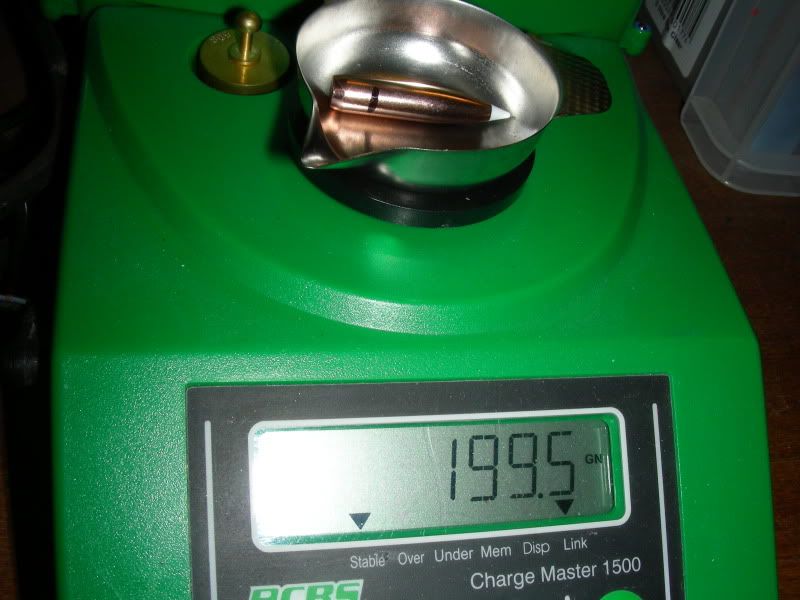
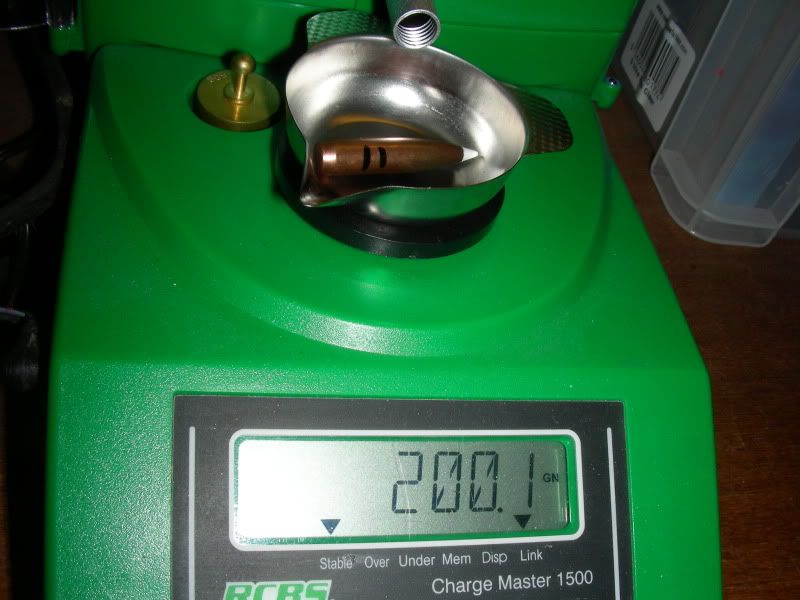
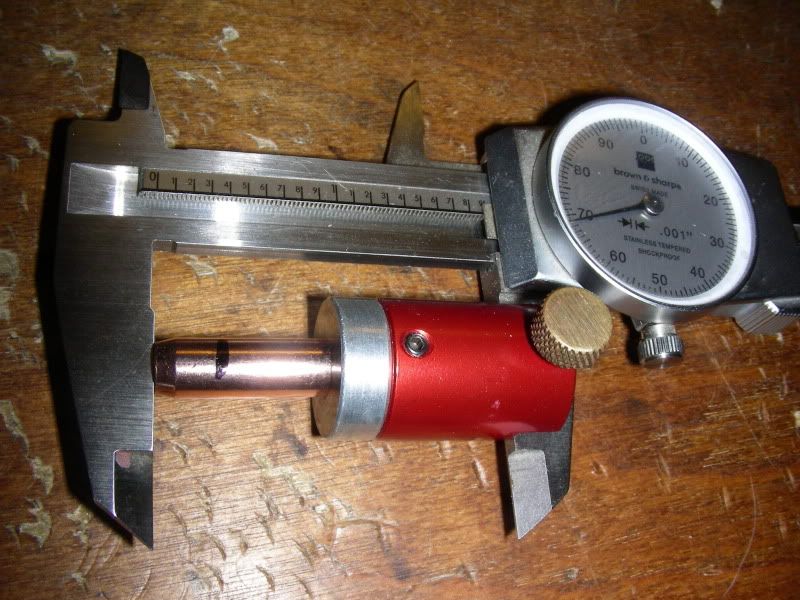
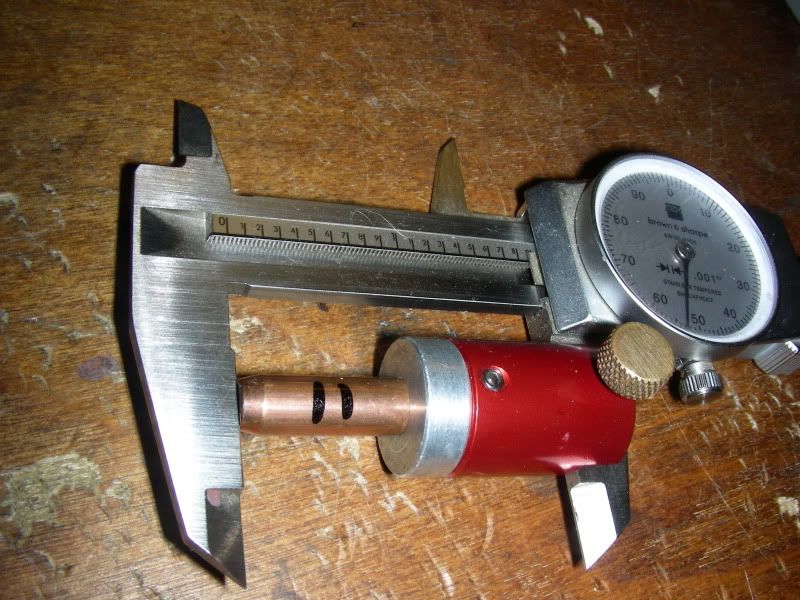
these will effect seating depths.
Then I size most calibers with a Lee Collet which gives the most consistant ID when compared to bushing dies or expander type dies. I check this with pin gauges which come in .001" sizes, although you can tell if there is a smaller change by how tight or loose the pin gauge fits
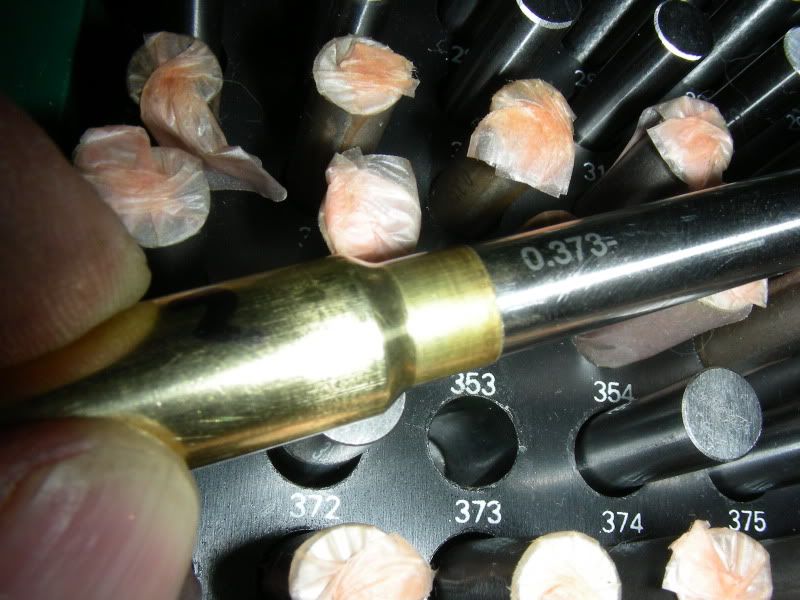
Then after inside and outside chamfering I thoroughly clean the inside of the neck to remove all burrs and scratches from sizing and chamfering which can have an effect on seating pressure
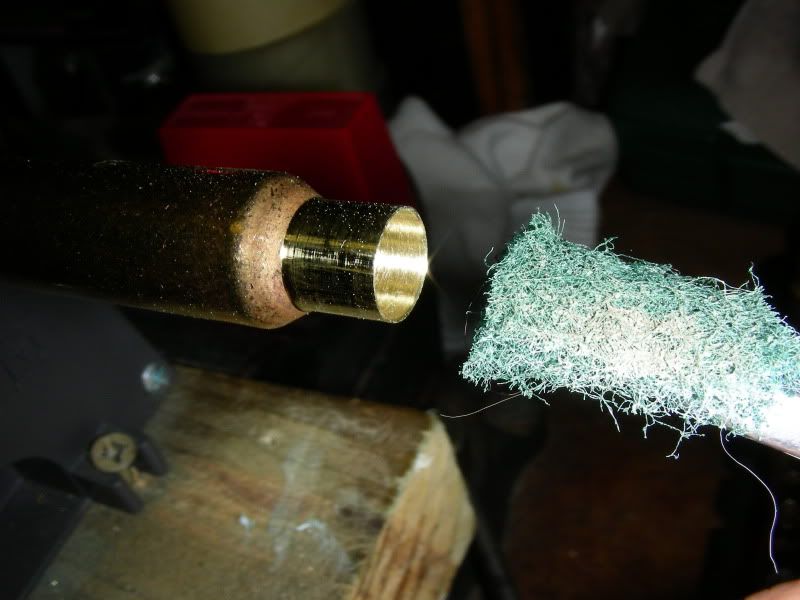
and treat with a dry lubricant, usually mica but sometimes Imperial dry lube
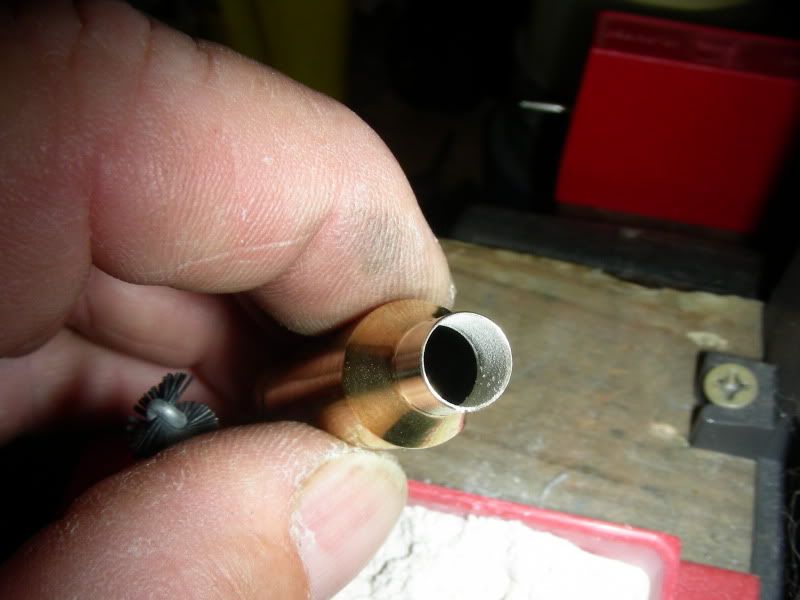
When seating the bullets I seat partway, rotate, seat, rotate until fully seated and then check with a comparator
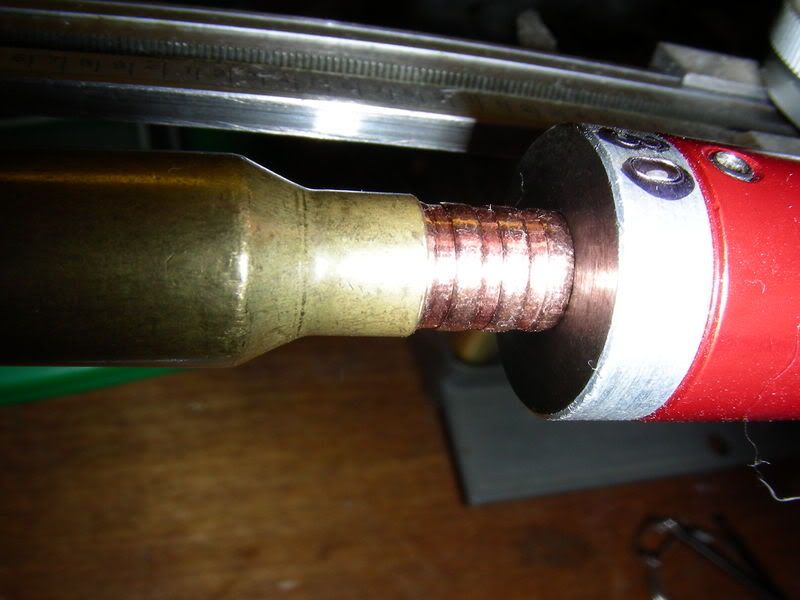
I have seated a block of 50 cases with less than .002" of variance but most of the time it will be slightly more.
To get anything less would be beyond the capabilities to measure as the comparator hits the bullet ogive at .011" below caliber and the lands of the rifle will hit at .008" less. The seating stems of even the Competition Seaters I use hit the ogive at close to .050" below caliber (30 caliber seating stem below)

and there can be variance introduced because of variances in the ogive curve between where the seating stem hits and where the comparator hits the bullet.
So any helpful suggestions about how to improve upon seating depth variance would be welcome. If you can seat to a variance of .005" or less then excellent. But if you are only varying your seating depth by .005" then how do you know you are not close to overlapping between the seating depths changes in your ladder. Is the research at Berger to be completely discounted?
Also I reload for over 40 different rifles in many calibers and keep track of distance to the lands on a spreadsheet and you will have .005" of throat erosion within 30 to 50 shots the amount of which will vary depending upon how heavy a load and how slow a powder you are using.
Any suggestions for improving my technique would be appreciated.
First I gauge all the bullets for bearing length to find bullets with large variances like these 200 gr Accubonds




these will effect seating depths.
Then I size most calibers with a Lee Collet which gives the most consistant ID when compared to bushing dies or expander type dies. I check this with pin gauges which come in .001" sizes, although you can tell if there is a smaller change by how tight or loose the pin gauge fits

Then after inside and outside chamfering I thoroughly clean the inside of the neck to remove all burrs and scratches from sizing and chamfering which can have an effect on seating pressure

and treat with a dry lubricant, usually mica but sometimes Imperial dry lube

When seating the bullets I seat partway, rotate, seat, rotate until fully seated and then check with a comparator

I have seated a block of 50 cases with less than .002" of variance but most of the time it will be slightly more.
To get anything less would be beyond the capabilities to measure as the comparator hits the bullet ogive at .011" below caliber and the lands of the rifle will hit at .008" less. The seating stems of even the Competition Seaters I use hit the ogive at close to .050" below caliber (30 caliber seating stem below)

and there can be variance introduced because of variances in the ogive curve between where the seating stem hits and where the comparator hits the bullet.
So any helpful suggestions about how to improve upon seating depth variance would be welcome. If you can seat to a variance of .005" or less then excellent. But if you are only varying your seating depth by .005" then how do you know you are not close to overlapping between the seating depths changes in your ladder. Is the research at Berger to be completely discounted?
Also I reload for over 40 different rifles in many calibers and keep track of distance to the lands on a spreadsheet and you will have .005" of throat erosion within 30 to 50 shots the amount of which will vary depending upon how heavy a load and how slow a powder you are using.
Any suggestions for improving my technique would be appreciated.
Similar threads
- Replies
- 17
- Views
- 3K



